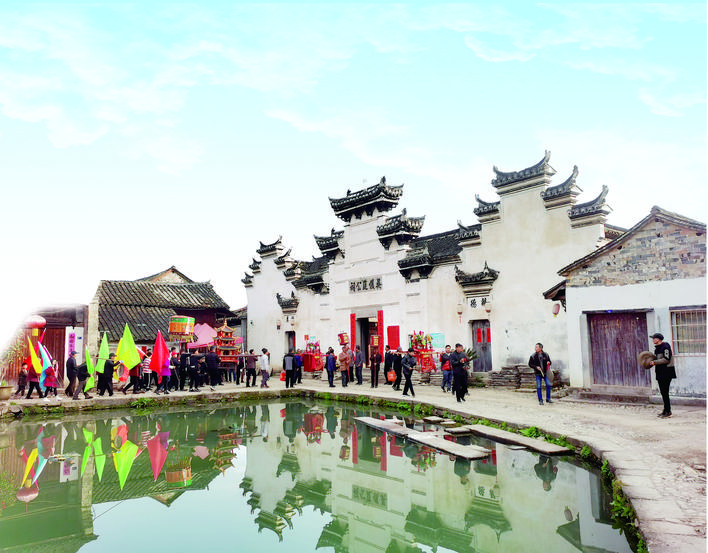发布时间: 2021-03-09
The Jinhua Culture, Broadcasting and Tourism Bureau announced the fifth batch of municipal intangible cultural heritage tourist attractions, including a total of 22 cities, like Zhuma Township in the Wucheng District; identifying 6 intangible cultural heritage theme towns, and 16 folk culture villages. According to statistics, Jinhua holds a total of 98 city-level intangible cultural heritage tourist attractions, including 32 intangible cultural heritage theme towns and 66 folk culture villages.
Here is reported the cultural charm of three municipal intangible cultural heritage sites.
Xiantan’s Heritage and Folk Customs
Next to Lanxi’s Bailu Mountain sits the alluring village of Xiantan, Nübu Subdistrict. In the fifth batch of municipal intangible cultural heritage sites, Xiantan is included as folk culture village. Dating back over 1200 years in history, the village was included in the second batch of traditional Chinese historical villages in 2013. Xiantan was home of the first grand councilor from Jinhua, Shu Yuanyu(舒元舆; died December 17, 835), and was also where the historical character of the Southern Song Dynasty Zhou Sanwei, famous and respected for his loyalty, lived in seclusion. In addition to the beauty of the natural scenery, the Yongling and Renshou pagodasconstitute equally attractive sights in the broad countryside.
The village presents several ancient buildings and two ancestral halls, which are now restored and well-preserved. In order to make full use of these historical buildings, the city of Lanxi established in the village bases to promote cultural activities like painting, tea culture, and local opera.
Last year, Chen Xiaohong and a few of her friends came to the village with their children. In one of the historical halls, they learned calligraphy and clay sculpture from a local master. Remembering this, Mrs. Chen said: “It was a great learning experience.” Not many clay sculptors are left among the villagers, and Zhou Yuelong is one of them. Master Zhou usually works on his sculptures either in the village or in the old streets of Nübu.
Traditional elements of intangible cultural heritage are everywhere in the village, including woodcarvings, clay sculptures, and handmade drums. In these two years, Xiantan has further discovered historical and cultural features of the local culture, and intangible culture is becoming a bright spot of local rural tourism.
Houwu Village and Master Hu’s Festival
Local celebrations on February 24 lit up the scene in the village of Houwu, Yongkang. Located 15 km from Yongkang, the village was founded during the Jiading years of the Southern Song Dynasty. With a history of about 800 years, the village now counts over 3900 inhabitants and is the homeplace of several talents.
The village seems to be protected by the nearby Pingshan (屏山 lit. Screen Mountain) mountain and spreads widely over the plain. From the Pingshan Mountain spring and flow two creeks, Diannan Creek and Lailong Creek. They both flow around the village, surrounding it, and merge into one on the northwest of the village, flowing into Yongkang’s largest river—Nanxi River.
Houwu records the most complete complex of historical buildings in Yongkang. The village preserves nearly a hundred of these buildings, among which are halls and dwellings of Song, Yuan, Ming, and Qing eras.
“The old village is basically a circle with a diameter of about 550 meters,” said villager Wu Fangxiao. Among them, it is a must to mention the Wus Ancestral Hall: The exquisite relief sculptures on the beams, brackets, and corbels of the ancestral hall are vivid. The original name of the ancestral hall, Xulun Tang (叙伦堂 lit. Assessing Normal Human Relations Hall) hangs on a tablet in the middle of the central hall. On the sides of the upper central hall, there are plaques of the ancestral titles and imperial examination results (Jinshi). More than 100 plaques hang around the outer corridor of the wing room, showing the rich tradition and glory of the Wu clan.
“The village counts more than 20 ponds of running water, some larger and some smaller; they serve both as fire prevention and civilian uses,” said Wu Fangxiao. And went on to say that the village was named as a traditional Chinese historical village in 2016 and has conserved traditional customs and local festivals.
Unique Features of She’s Culture
Zhong Zhongxian, a She native of Liucheng, Wuyi, sings about herself on a viral video on TikTok. Like her great-grandfather, grandfather, and father, Mrs. Zhong is an authentic descendent of She ethnicity and folk song. “Since I was seven years old, I have heard my grandparents singing,” said Mrs. Zhong. She continued saying that fewer and fewer people can speak the She language and sing the songs, “Most of our people don’t know much about our tradition.” Mrs. Zhong is also an extra-curricular tutor at Liucheng She Town Central Primary School. She teaches singing.
In addition, as an Intangible Cultural Heritage Town, Liucheng established the She Ethnicity Colored Ribbon Art Museum last year. The craft of colored ribbon incorporates unique ethnic characteristics into the craftsmanship. Ribbon weaving master Zhong Zhenlian has been doing it since the age of 12 with her mother. During the holidays, many tourists and students visit the art museum to learn She’s craftsmanship.
“The growth of tourism in Liucheng is taking advantage of cultural differences to create a cultural brand for characteristic festivals,” explained Lan Xiaochun, deputy director of Liucheng Development Office.
In recent years, in order to rediscover and protect local intangible cultural heritage, Liucheng has carried out a series of projects to promote unique folk activities, attract a large number of tourists, and put on display intangible cultural heritage elements. (By Xia Binting, photo by Tang Xuyu, translated by Marco Lovisetto, edited by Mariam Ayad)

Traditional celebrations in Houwu Village

Local traditional wedding (photo provided by Li Xiaotan)
非遗点睛 文旅添韵
今年,金华市文化广电旅游局公布了第五批金华市非物质文化遗产旅游景区名单,共有婺城区竹马乡等22家,其中非遗主题小镇6处、民俗文化村16处。据统计,截至目前,我市共有市级非物质文化遗产旅游景区98处,其中非遗主题小镇32处、民俗文化村66处。
这几天,记者实地走访了3处市非物质文化遗产旅游景区,品读它们的文化魅力。
文豪忠良厚底蕴 民俗风情惹人恋
兰溪白露山旁,坐落着一座风光秀丽的村落——女埠街道垷坦村。金华市文旅局公布的第五批金华市非物质文化遗产旅游景区名单里,垷坦村被评为金华市民俗文化村。垷坦村有1200多年历史,2013年被确定为第二批中国传统古村落。
这里,是从金华出去的第一个宰相舒元舆的故里,也是南宋忠良周三畏的隐居地。除了自然风光,遥相呼应的永龄塔和仁寿塔在宽广的田园中同样吸引人。
古时垷坦有十厅两祠堂,如今都修缮保存完好。充分利用古村的遗存,如今,这里相继成立了兰溪市书画基地、茶文化基地、戏曲基地等,带动乡村振兴和旅游。
去年,市民陈小红和几位朋友带着孩子们到垷坦进行了一场亲子游。在另一个厅里,跟着当地师傅写字、做泥塑。她说:“是一次很好的研学之旅。”
从事泥塑行当的民间艺人不多了,村民周跃龙是其中一位。平日里,周跃龙在村里或女埠古街上做泥塑。
在垷坦,非遗元素随处可见。传统非遗手工木雕、泥塑、击鼓,还有金华市级非遗鸾驾等,这两年,垷坦村进一步挖掘历史文化、传统文化、非遗文化、忠孝文化,文化已成为乡村旅游的一个亮点。
“这是我们村每年正月十三的传统习俗——迎胡公。”
2月24日,记者被永康市后吴村的一处场景吸引了。
后吴村距离永康市区15公里。该村始建于南宋嘉定十年,经过近800年的风雨洗礼,现成为拥有3900多人的大村落,人才辈出。
村前有座形似官帽的屏山,全村地势开阔平坦。“吴方晓说,屏山引来的两股山泉水,一股殿南溪、一股来龙溪,各环绕半个村落,最后两溪在村西北处汇合,流入永康最大的溪流——南溪。
后吴村有永康最完整的古建筑群,整个村现存宋、元、明、清厅堂楼宇、民宅大院、庐墅精舍近百幢,总数1000多间。
“老村基本是个圆形,直径550米左右。”吴方晓说,绕村走上一圈,至少也得两个小时。其中,不得不提的自然是吴氏宗祠。宗祠内的抬梁、斗拱、牛腿上精美的浮雕栩栩如生,宗祠的中堂正中悬挂着宗祠的堂号“叙伦堂”,在上中厅内左右两旁挂着本族祖先历任的官衔和科举进士等匾额,意为显耀门庭;厢房外侧回廊四周挂满100多块匾额,意在昭示后吴曾经的传统和辉煌。
村里有大大小小20多口池塘,且都是活水,一为防火,二为民用。”吴方晓说。
“我们村2016年被评为中国传统村落,至今保持着农历十月初十民俗文化节等传统活动。”
畲歌畲艺展风采
文化差异创特色
钟忠仙,武义柳城畲族镇土生土长的畲家女。她的太公、爷爷、父亲,都是武义畲族山歌传承人。七八岁时跟着爷爷奶奶,他们唱,我就听。”钟忠仙说。
“现在会说畲语、会唱畲歌的人越来越少,大家对畲族文化了解得也并不深入。”现在,钟忠仙还是柳城畲族镇中心小学的校外辅导老师,教学生畲语畲歌。
作为非遗小镇,柳城畲族镇去年打造了一个“畲族彩带技艺馆”。畲族彩带是颇具民族特色的工艺品,彩带编织传承人钟振莲12岁时就跟着母亲学习,从短带、小带织起。节假日,不少游客和学生会到技艺馆参观学习畲家技艺。
“柳城旅游就是利用文化差异,打造品牌文化节庆特色。”镇经发办副主任蓝晓春介绍。
近年来,为做好非遗资源的挖掘、抢救与保护工作,柳城镇政府开展了一系列工作,独特的民俗活动吸引了大量游客前来,非物质文化遗产的展示与传承已成为柳城旅游经济的重要内容。(记者 夏斌婷 唐旭昱 文/摄)
制图
后吴村举办迎胡公的传统习俗活动
图1
婚俗非遗活动 李笑谈供图

